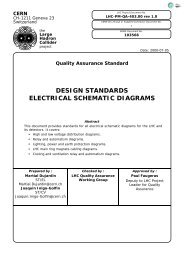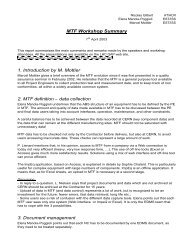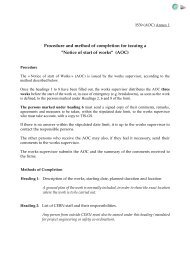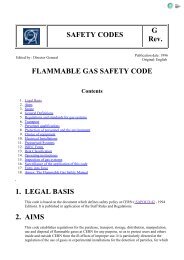naming conventions for buildings and civil engineering works - CERN
naming conventions for buildings and civil engineering works - CERN
naming conventions for buildings and civil engineering works - CERN
You also want an ePaper? Increase the reach of your titles
YUMPU automatically turns print PDFs into web optimized ePapers that Google loves.
<strong>CERN</strong><br />
CH-1211 Geneva 23<br />
Switzerl<strong>and</strong><br />
the<br />
Large<br />
Hadron<br />
Collider<br />
project<br />
LHC Project Document No.<br />
LHC-PM-QA-207 rev. 1.0<br />
<strong>CERN</strong> Div./Group or Supplier/Contractor Document No.<br />
AC/TCP<br />
EDMS Document No.<br />
107398<br />
Date: 1999-11-16<br />
Quality Assurance Definition<br />
NAMING CONVENTIONS FOR BUILDINGS<br />
AND CIVIL ENGINEERING WORKS<br />
Abstract<br />
This document provides rules <strong>for</strong> defining st<strong>and</strong>ard abbreviations <strong>for</strong> the LHC surface<br />
<strong>buildings</strong> <strong>and</strong> the various parts of the underground Civil Engineering <strong>works</strong>. These<br />
abbreviated names will be of prime importance, as they will be the main key to retrieve<br />
all the in<strong>for</strong>mation of a given building in the different data bases <strong>and</strong> will provide a<br />
common language <strong>for</strong> all groups involved in the LHC Collider project, inside <strong>and</strong> outside<br />
<strong>CERN</strong>.<br />
This document is based on <strong>and</strong> supersedes the LHC Project Report 92 on Naming<br />
Conventions <strong>for</strong> the Large Hadron Collider Project [1].<br />
Prepared by :<br />
Roberto Saban<br />
Checked by :<br />
Quality Assurance<br />
Working Group<br />
Approved by :<br />
Paul Faugeras<br />
Jean-Luc Baldy
LHC Project Document No.<br />
LHC-PM-QA-207 rev. 1.0<br />
Page 2 of 7<br />
History of Changes<br />
Rev. No. Date Pages Description of Changes<br />
1.0 draft<br />
1.0<br />
1999-10-07<br />
1999-11-16<br />
Submitted <strong>for</strong> approval<br />
First published
LHC Project Document No.<br />
LHC-PM-QA-207 rev. 1.0<br />
Page 3 of 7<br />
Table of Contents<br />
1. PURPOSE ................................................................................................ 4<br />
2. POLICY ................................................................................................... 4<br />
3. SCOPE..................................................................................................... 4<br />
4. RESPONSIBILITIES................................................................................. 4<br />
4.1 PROCEDURE FOR THE CREATION OF ABBREVIATIONS ................................. 4<br />
5. CIVIL ENGINEERING WORKS .................................................................. 4<br />
5.1 ABBREVIATION DEFINITION ..................................................................... 5<br />
5.2 WORKS TYPE .......................................................................................... 6<br />
5.2.1 FIRST CHARACTER........................................................................................ 6<br />
5.2.2 SECOND CHARACTER .................................................................................... 6<br />
5.2.3 THIRD CHARACTER ....................................................................................... 6<br />
5.3 WORKS NUMBERING................................................................................ 7<br />
6. BUILDING NUMBERING........................................................................... 7<br />
7. RELATED DOCUMENTATION .................................................................... 7
LHC Project Document No.<br />
LHC-PM-QA-207 rev. 1.0<br />
Page 4 of 7<br />
1. PURPOSE<br />
2. POLICY<br />
This document provides rules <strong>for</strong> defining st<strong>and</strong>ard abbreviations <strong>for</strong> the LHC surface<br />
<strong>buildings</strong> <strong>and</strong> the various parts of the underground Civil Engineering <strong>works</strong>. These<br />
abbreviated names will be of prime importance, as they will be the main key to<br />
retrieve all the in<strong>for</strong>mation of a given building in the different data bases <strong>and</strong> will<br />
provide a common language <strong>for</strong> all groups involved in the LHC Collider project, inside<br />
<strong>and</strong> outside <strong>CERN</strong>.<br />
This document is based on <strong>and</strong> supersedes the LHC Project Report 92 on Naming<br />
Conventions <strong>for</strong> the Large Hadron Collider Project [1].<br />
The increasing size of the colliders <strong>and</strong> there<strong>for</strong>e the distribution of the <strong>buildings</strong> over<br />
vast areas <strong>and</strong> their numbers has led to their <strong>naming</strong> using abbreviated names. These<br />
are constructed using a predefined number of alphanumeric characters. Rules are<br />
defined <strong>for</strong> the choice <strong>and</strong> the meaning of each character <strong>and</strong> its position in the name.<br />
The abbreviated names are chosen so that they reflect as closely as possible the<br />
nature <strong>and</strong> the usage of the building. However, a building or <strong>civil</strong> <strong>engineering</strong> <strong>works</strong><br />
the usage of which changes from LEP to LHC will retain its original name.<br />
3. SCOPE<br />
The <strong>naming</strong> <strong>conventions</strong> described in the present document apply to the LHC surface<br />
<strong>buildings</strong>, its pits, underground <strong>works</strong> including the collider tunnel, its injection<br />
transfer lines TI2 from TT60 <strong>and</strong> TI8 from TT40 <strong>and</strong>, <strong>and</strong> its external beam lines.<br />
4. RESPONSIBILITIES<br />
4.1 CHANGE OF NAMING CONVENTIONS<br />
Any change or revision of the <strong>naming</strong> <strong>conventions</strong> must be endorsed first by the<br />
Parameter <strong>and</strong> Layout Committee <strong>and</strong> by the Technical Coordination Committee. The<br />
revised version must then be approved by the Project Leader or by his Deputy <strong>for</strong><br />
Quality Assurance.<br />
4.2 PROCEDURE FOR THE CREATION OF ABBREVIATIONS<br />
New abbreviations <strong>for</strong> Civil Engineering <strong>works</strong> are defined by the Infrastructure<br />
Section of the EST/ESI Group, under the responsibility of its Section Leader, who must<br />
in<strong>for</strong>m LHC Project Deputy <strong>for</strong> Quality Assurance <strong>and</strong> the Leader of the “Real Estate<br />
Data <strong>and</strong> Drawings”Section of the Technical Facility Management (ST/TFM) Group.<br />
This latter person must also keep up-to-date the dictionary of Works Types.<br />
5. CIVIL ENGINEERING WORKS<br />
The LHC Collider, [2], will be installed in the existing LEP tunnel <strong>and</strong> its geometry will<br />
closely follow that of the LEP machine. Most of the infrastructure built <strong>for</strong> LEP will be<br />
needed <strong>for</strong> LHC. In particular, the access points to the tunnel <strong>and</strong> the service areas on<br />
the surface will be concentrated around the existing LEP access points, which are
++++++ +<br />
LHC Project Document No.<br />
LHC-PM-QA-207 rev. 1.0<br />
Page 5 of 7<br />
numbered from 1 to 8, in the clockwise direction starting with Point 1 opposite to the<br />
main entrance of the Meyrin site, see Fig. 1 below.<br />
Gex<br />
Cessy<br />
Echenevex<br />
+++<br />
Point 4<br />
L E P<br />
/ L H C<br />
Point 5<br />
Versonnex<br />
++++++++ ++<br />
+ + ++++++ +<br />
Crozet<br />
Point 3<br />
Chevry<br />
Ségny<br />
Ornex<br />
+++++++++++++++++ +++<br />
Point 6<br />
+ +++++++<br />
+<br />
Collex-Bossy<br />
++++++++<br />
Point 3.2<br />
<strong>CERN</strong><br />
Site de Prévessin<br />
Point 7<br />
+++++++++ ++ ++<br />
+++<br />
Sergy<br />
Point 2<br />
Prévessin-Moëns<br />
St Genis-Pouilly<br />
++++++++<br />
TI 2<br />
+++ +++++++++++++++<br />
+++++++++++++<br />
++<br />
++ +++++++++++++++<br />
Point 1.8<br />
S P S<br />
Point 1<br />
<strong>CERN</strong><br />
Site de Meyrin<br />
+++++++++++<br />
+++<br />
+<br />
TI 8<br />
Meyrin<br />
+++<br />
+++ +++++ +<br />
Point 8<br />
+++++++++++++<br />
Ferney-Voltaire<br />
+++++<br />
++++++ +++++++++++++++<br />
++++ ++ + +++<br />
Figure 1: Overall map of the LEP/LHC tunnel<br />
The abbreviation system used <strong>for</strong> the LEP surface <strong>buildings</strong> <strong>and</strong> underground <strong>works</strong><br />
will there<strong>for</strong>e be kept <strong>for</strong> LHC. New <strong>works</strong> will be identified according to this system,<br />
while existing installations will keep their LEP name, even if their usage <strong>for</strong> LHC is<br />
different.<br />
5.1 ABBREVIATION DEFINITION<br />
Each name is made of up to six alphanumeric characters, split in two groups of three.<br />
The first group is alphabetic <strong>and</strong> defines the <strong>works</strong> type <strong>and</strong> the second the <strong>works</strong><br />
number. This convention is totally con<strong>for</strong>m to the Naming <strong>conventions</strong> <strong>for</strong> LEP<br />
<strong>buildings</strong> <strong>and</strong> Civil Engineering [3].
LHC Project Document No.<br />
LHC-PM-QA-207 rev. 1.0<br />
Page 6 of 7<br />
5.2 WORKS TYPE<br />
5.2.1 FIRST CHARACTER<br />
The first character of the <strong>works</strong> type determines the kind of Civil Engineering <strong>works</strong>,<br />
according to the following list:<br />
P = Pit<br />
R = Ring underground <strong>works</strong> on the beam path<br />
S = Surface <strong>buildings</strong><br />
T = Tunnels <strong>and</strong> underground galleries<br />
U = Tunnel enlargements, experimental caverns, other underground<br />
<strong>works</strong> which are not directly on the beam path.<br />
5.2.2 SECOND CHARACTER<br />
It indicates the main usage of the building <strong>and</strong> underground work, with the following<br />
list:<br />
A = Acceleration <strong>and</strong> Radio-frequency equipment<br />
B = Equipment <strong>for</strong> Low Beta section<br />
C = Controls <strong>and</strong> Communications<br />
D = Material unloading<br />
E = Electricity<br />
F = Fluids<br />
G = Gas <strong>for</strong> detectors<br />
H = Cryogenics<br />
I = Injection<br />
J = Junction caverns<br />
L = Liaison galleries<br />
M = Magnets <strong>and</strong> other machine equipment<br />
P = Personnel Protection <strong>and</strong> Fire Brigade<br />
R = Power Converters<br />
S = Services<br />
T = Beam transfer<br />
U = Ventilation<br />
W = Water<br />
X = Experiments<br />
Y = Access control<br />
Z = Access<br />
Note that some of the letters above have a meaning which is different from the<br />
system definition given in LHC-PM-QA-204.<br />
5.2.3 THIRD CHARACTER<br />
This character is optional <strong>and</strong> is used either to be more precise on the usage of the<br />
<strong>works</strong> concerned or to distinguish between different specific parts of that <strong>works</strong> or to<br />
distinguish two <strong>works</strong> having a similar usage. Special rules are defined <strong>for</strong> each case.<br />
This facility is mainly used <strong>for</strong> electrical <strong>buildings</strong> <strong>and</strong> <strong>for</strong> experimental halls or when<br />
an existing building has to be extended <strong>for</strong> LHC.
LHC Project Document No.<br />
LHC-PM-QA-207 rev. 1.0<br />
Page 7 of 7<br />
A web page [4] gives the list of <strong>civil</strong> <strong>engineering</strong> <strong>works</strong> abbreviations actually in use.<br />
5.3 WORKS NUMBERING<br />
Up to three digits follow the <strong>works</strong> type <strong>and</strong> are used to localize the <strong>works</strong> concerned.<br />
The first numeric character is the octant number defined as the LEP access point (see<br />
chapter 5, first paragraph). The digit 0 is used <strong>for</strong> designing the whole LHC site, while<br />
9 is used <strong>for</strong> zones outside the <strong>CERN</strong> domain. The second digit allows a more precise<br />
localization with respect to the middle of the octant: this point (the <strong>for</strong>mer LEP<br />
collision point) is given the number 5 <strong>and</strong> the octant is split in equal parts, numbered<br />
from 1 to 9 in the clockwise direction. The last <strong>and</strong> optional digit can be used <strong>for</strong><br />
specifying the floor number of a building <strong>for</strong> instance or <strong>for</strong> distinguishing between two<br />
neighboring <strong>works</strong> in an underground area.<br />
6. BUILDING NUMBERING<br />
The <strong>CERN</strong> patrimony is kept by the Technical Facility Management Group in the ST<br />
Division. The Civil Engineering Group in the ST Division is responsible <strong>for</strong> the <strong>civil</strong><br />
<strong>engineering</strong> design <strong>and</strong>/or <strong>works</strong> carried out on all <strong>CERN</strong> sites <strong>for</strong> the LHC Civil<br />
Engineering Project in collaboration with the architects experts, consultants <strong>and</strong><br />
contractors.<br />
The TFM Group keeps an inventory of the <strong>buildings</strong> <strong>and</strong> <strong>works</strong>. These are numbered (4<br />
digits) following ST specific rules. The inventory is accessible via the web pages of the<br />
ST-CE group [4]. This page describes the usage of the building <strong>and</strong> gives the<br />
correspondence between the ST names <strong>and</strong> the LEP/LHC names.<br />
7. RELATED DOCUMENTATION<br />
[1] Naming Conventions <strong>for</strong> the Large Hadron Collider Project, P.Faugeras,<br />
P.Lefèvre, LHC Project Report 92, March 1997.<br />
[2] The Large Hadron Collider, Conceptual Design, The LHC Study Group,<br />
<strong>CERN</strong>/AC/95-05, 20 October 1995.<br />
[3] Installation du LEP - Plan d'Hygiène et de Sécurité - Règlement de Chantier,<br />
<strong>CERN</strong><br />
[4] http://nicewww.cern.ch/st/ce/lhc/ListeStruc.htm
















